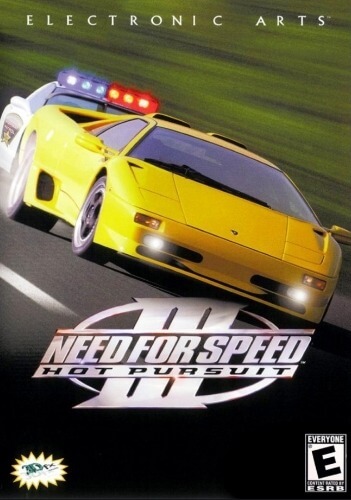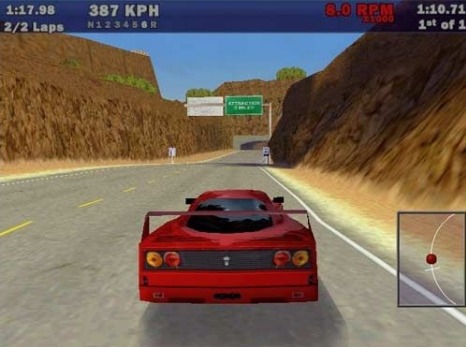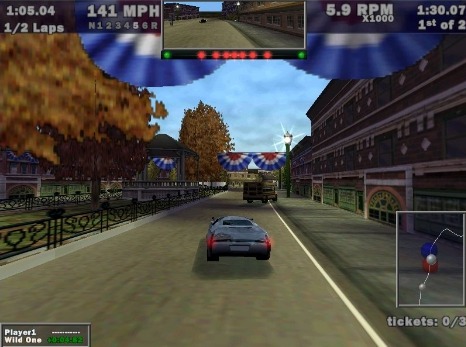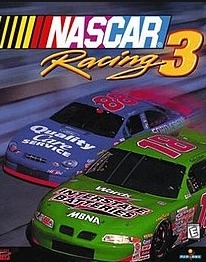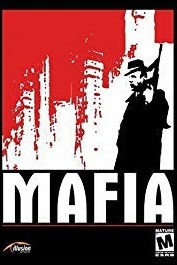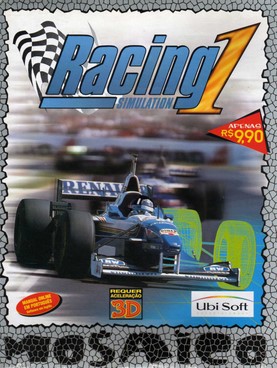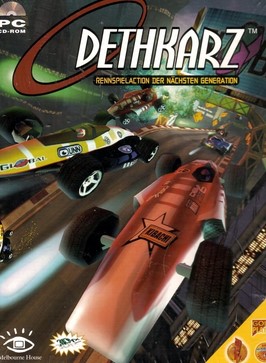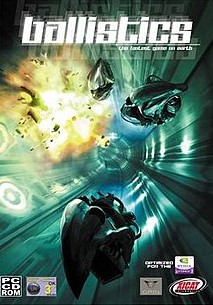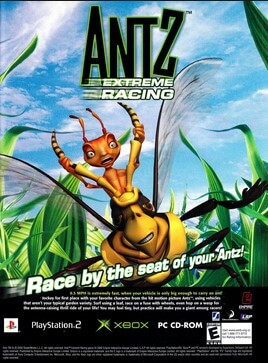Each race consists of two laps where the driver who finishes last will be eliminated from the race lineup. All other drivers advance to the next round and carry on with the battle until there is only one player left, who technically wins the knockout competition. The standard "Tournament" mode consists of eight opponents in a four-lap race on randomly selected tracks and choices made by the player as in the knockout mode take effect when the tournament is started. The game supports network play through a serial port, modem, or IPX, and online gaming through TCP/IP protocol. It also allowed spawn installations of itself to be installed on other machines.
Racing tracks are greatly varied, with settings ranging from wide desert canyons to homely countryside villages, as well as snow-capped mountain ranges. Two particular tracks in the game (Atlantica and Aquatica) are host to a modern and intricate structure identified as the Electronic Arts development office. Most tracks contain one or more secret shortcuts which can dramatically alter the outcome of a race. The tracks in the game are: Hometown, Redrock Ridge, Atlantica, Rocky Pass, Country Woods, Lost Canyons, Aquatica and The Summit. There is also an unlockable secret track called Empire City (unlocked after completing knockout mode in beginner difficulty).
The game also boasted some fairly impressive graphics support for its time, allowing up to 1152 by 864 pixels, 16-bit in-game resolution; widescreen support, car chrome effects, and slider settings for car detail and view distance. Motion-sensing controllers received support as well, granting the players a more thorough gameplay experience by actually allowing them to "drive" the cars.
Car tuning was also introduced, which allowed any car's handling to be customized by adjusting low or high-end properties for engine tuning and gear ratios, front or back brake balance, slow or fast braking speed, soft or stiff suspension, low or high aerodynamics as well as rain or racing tires. Any of these options could be modified via sliders to offer a digit-sensitive, percentage-based effect to the selected car's overall performance. Higher-end engine and gear tuning, for example, will compromise acceleration for better top speed. Rear-based brake balance and slow braking speeds make for wider, drifting turns, and aerodynamics provide even higher speeds at the loss of handling.
Pursuit system
Hot Pursuit's pursuit system has been significantly improved in terms of AI and police tactics over The Need for Speed. The game now requires that the racer only stops near a pursuing police car to be ticketed or arrested by the police, as opposed to being overtaken by a police car, forcing the racer to pull over for the same punishments. Accordingly, police cars are now programmed with the ability to block a racer's car in an attempt to halt them. In addition, whereas the original Need for Speed would only have a single police car chasing a racer in each pursuit, Hot Pursuit allows more police cars to pursue a racer, opening up the opportunity for them to collectively ambush the racer's car. The police version of the sports cars is only playable in the PC version. However, the police cars can be played in the PS1 version, through hacking with a GameShark. The player must select a car in Hot Pursuit mode, which will then be replaced by a police car when the race starts. The CLK-GTR, and El Niño (a fictional bonus car) cannot be replaced. Even when driving a police car in the PS1 version, the police can still arrest the player.
Tactical aspects of the police pursuits have also been improved. The police have the ability to deploy roadblocks which has computer-controlled police cars form a wall across the road, and spike strips which puncture the tires of a racer's car, bringing it to a halt. Both tactics present weaknesses, specifically gaps in the blockade that can be used by a racer to avoid collisions with police cars, or tire punctures from a spike strip which is only deployed on one side of the road. The player may also listen to police radio chatter on the pursuits' statuses, revealing to them the current locations of racers, police cars, as well as roadblocks and spike strips. The radio chatter also reveals reactions to specific events, such as a racer's collision with a parked police car, as well as referencing the racer's passing speed and the occurrence of the race itself ("It looks like the cars are racing!"). Furthermore, if a computer-controlled racer's driving conduct proves to be more dangerous (also chosen by the player) than that of the racer's, the police may relent their pursuit of the player and chase the AI instead.
Each track setting features unique police cars, including three sedan-based squad cars, a hatchback and two SUVs. The Chevrolet Caprice Classic (for Hometown and Country Woods and sometimes also appears on the Redrock Ridge and Lost Canyons tracks in the PS1 version only) Ford Crown Victoria (for Hometown, Country Woods, and Empire City in PC version and Atlantica and Aquatica and sometimes also on the Rocky Pass and Summit tracks for the PS1 version), Eagle Talon (for Lost Canyons and Redrock Ridge for the PC version and Empire City in the PS1 version), Ford Falcon or Pontiac Grand Am (for Atlantica and Aquatica in the PC version only), Lamborghini LM002 (For Rocky Pass and Summit in the PS1 version only) and Land Rover Discovery (for Rocky Pass and Summit in the PC version and Lost Canyons and Redrock Ridge in the PS1 version). In addition to standard police cars, a handful of Chevrolet Corvette C5 police cars are also included in each track, more equipped to engage in high-speed pursuits and capable of outperforming normal police cars. In the PS1 version, the Lamborghini Diablo pursuit vehicles replace the Corvette if Expert difficulty is selected.
